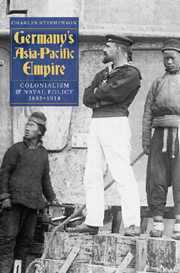Book contents
- Frontmatter
- Contents
- List of Illustrations
- List of Maps and Tables
- Introduction
- 1 Bismarck and Empire: 1885–1888. Kaiser Wilhelm's Land, the Bismarck Archipelago, the Marshall Islands and Nauru
- 2 The Acquisition of Kiautschou: 1897
- 3 China 1897–1914: Colonial Development and Political Turbulence
- 4 Tectonic Shift 1: 1898–1899. Spain and the USA, Germany, Micronesia and Samoa
- 5 Tectonic Shift 2: 1902–1914. Japan and Russia, Britain and Dominion Defence, the United States
- 6 War. August 1914
- 7 Naval Plans and Operations 1897–1914
- 8 Kiautschou: Naval and Military Operations 22 August–28 September 1914
- 9 Tsingtau: Naval and Military Operations 28 September–7 November 1914
- 10 Aftermath
- Notes to the Text
- Bibliography
- Index
7 - Naval Plans and Operations 1897–1914
Published online by Cambridge University Press: 12 September 2012
- Frontmatter
- Contents
- List of Illustrations
- List of Maps and Tables
- Introduction
- 1 Bismarck and Empire: 1885–1888. Kaiser Wilhelm's Land, the Bismarck Archipelago, the Marshall Islands and Nauru
- 2 The Acquisition of Kiautschou: 1897
- 3 China 1897–1914: Colonial Development and Political Turbulence
- 4 Tectonic Shift 1: 1898–1899. Spain and the USA, Germany, Micronesia and Samoa
- 5 Tectonic Shift 2: 1902–1914. Japan and Russia, Britain and Dominion Defence, the United States
- 6 War. August 1914
- 7 Naval Plans and Operations 1897–1914
- 8 Kiautschou: Naval and Military Operations 22 August–28 September 1914
- 9 Tsingtau: Naval and Military Operations 28 September–7 November 1914
- 10 Aftermath
- Notes to the Text
- Bibliography
- Index
Summary
The Kaiser and the Tsar met at Reval (Tallinn, now capital of Estonia) from 6 to 8 August 1902, an occasion when both were impressed by a demonstration of gunnery on the part of the Russian Baltic Fleet. They and their entourages viewed this display from the flagship of a somewhat irascible admiral named Zinovi Rozhdestvenski, who took the credit for organising and supervising the demonstration. The Kaiser was no doubt enthused by this display of naval strength, and on his departure signalled to the Tsar, undoubtedly to the latter's embarrassment, ‘The Admiral of the Atlantic Ocean salutes the Admiral of the Pacific.’
This might be considered simply as one of Wilhelm's witticisms, had he not signed himself off in a letter to the Tsar of 2 September in similar terms. Contained in this communication were some flights of Imperial fancy; the Kaiser urged the Tsar to look at ‘our two navies as one great organisation belonging to one great Continent whose interest it must safeguard on its shores and in distant seas. This means practically the Peace of the World.’ Perhaps Wilhelm had forgotten the Franco-Russian alliance of 1894.
- Type
- Chapter
- Information
- Germany's Asia-Pacific EmpireColonialism and Naval Policy, 1885–1914, pp. 117 - 130Publisher: Boydell & BrewerPrint publication year: 2009

